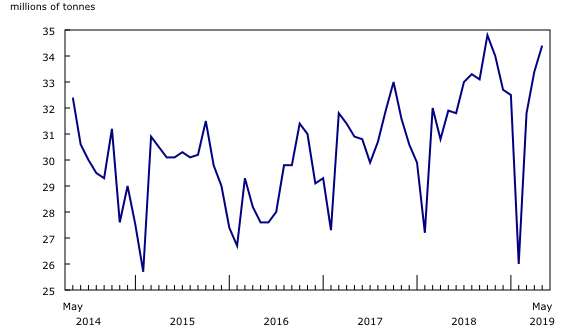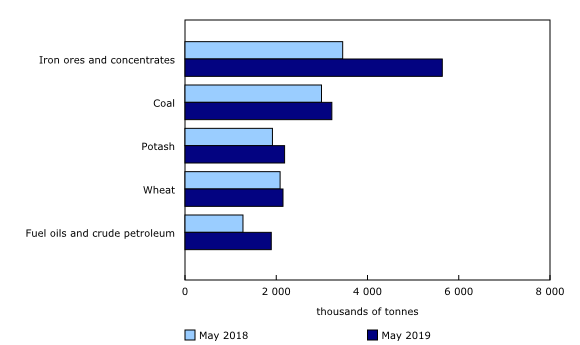Railway carloadings, May 2019
Archived Content
Information identified as archived is provided for reference, research or recordkeeping purposes. It is not subject to the Government of Canada Web Standards and has not been altered or updated since it was archived. Please "contact us" to request a format other than those available.
Released: 2019-07-31
34.4 million tonnes
May 2019
7.8% 
(12-month change)
The volume of rail freight carried in Canada totalled 34.4 million tonnes in May, up 7.8% from the same month a year earlier.
Total intermodal and non-intermodal freight loaded in Canada rose 10.4% from the same month a year earlier to 30.9 million tonnes in May 2019. The amount of non-intermodal freight rose 11.5% from May 2018 to 27.7 million tonnes.
The commodity with the largest year-over-year increase in tonnage was iron ores and concentrates (+2.2 million tonnes, or +63.1%). A workers' strike that took place in the mining sector in early 2018 could have had an impact on the transportation of this commodity, which declined markedly in April and May 2018.
Fuel oils and crude petroleum (+619 000 tonnes, or +48.7%), potash (+267 000 tonnes, or +13.9%), coal (+227 000 tonnes, or +7.6%), and gaseous hydrocarbons, including liquid petroleum gas (LPG) (+185 000 tonnes, or +36.9%), also posted large year-over-year increases.
In contrast, tonnages declined for other oil seeds and nuts and other agricultural products (-157 000 tonnes, or -51.6%), other cereal grains (-148 000 tonnes, or -33.8%), colza seeds (canola) (-148 000 tonnes, or -16.4%); lumber (-132 000 tonnes, or -11.8%); and iron and steel, primary or semi-finished (-128 000 tonnes, or -28.8%).
Intermodal freight loadings increased 0.4% from May 2018 to 215,000 units. In terms of weight, intermodal traffic increased 1.8% to 3.2 million tonnes.
Overall, freight traffic from the United States fell 11.1% to 3.5 million tonnes as a result of a 15.7% decrease in non-intermodal freight.
Note to readers
As of reference month January 2019, a change in the compilation of data affects the proportions between intermodal and non-intermodal data. It is therefore advisable to exercise caution when comparing data from 2019 with previous periods for these means of transportation.
Data from January to April 2019 have been revised. Data in this release are not seasonally adjusted.
The Monthly Railway Carloadings Survey collects data, including the number of rail cars, tonnage, units and 20-feet equivalent units, from railways operating in Canada that provide for-hire freight service.
Non-intermodal operations involve the movement of goods on the rail network only, excluding movements on switch tracks. They include goods transported by rail cars on ferries or barges when these are connected to railway tracks and form an integral part of the line route.
Intermodal operations involve more than one mode of transportation. Goods are carried in a highway trailer or freight container that is transferred between a rail car and some other mode of transportation, usually a truck or a ship.
Data are available for Canada, the eastern division and the western division. For statistical purposes, cargo loadings from Thunder Bay, Ontario, to the Pacific Coast are classified to the western division, while loadings from Armstrong, Ontario, to the Atlantic Coast are classified to the eastern division.
Contact information
For more information, or to enquire about the concepts, methods or data quality of this release, contact us (toll-free 1-800-263-1136; 514-283-8300; STATCAN.infostats-infostats.STATCAN@canada.ca) or Media Relations (613-951-4636; STATCAN.mediahotline-ligneinfomedias.STATCAN@canada.ca).
- Date modified:



